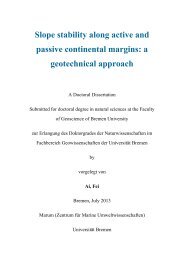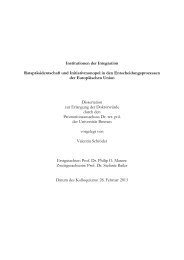Seismoacoustic Study of the Shallow Gas Transport and ... - E-LIB
Seismoacoustic Study of the Shallow Gas Transport and ... - E-LIB
Seismoacoustic Study of the Shallow Gas Transport and ... - E-LIB
You also want an ePaper? Increase the reach of your titles
YUMPU automatically turns print PDFs into web optimized ePapers that Google loves.
Chapter 5<br />
In addition to <strong>the</strong> feeder channels, three o<strong>the</strong>r types <strong>of</strong> pathways for gas <strong>and</strong> fluid<br />
migration could be recognized: columnar zones, acoustic curtains <strong>and</strong> faults. And three<br />
types <strong>of</strong> gas reservoirs in <strong>the</strong> central Black Sea are identified: a) Large gas/gas hydrate<br />
reservoirs around <strong>the</strong> feeder channels <strong>of</strong> mud volcanoes (BSZA); b) Large gas/gas<br />
hydrate reservoirs located above <strong>the</strong> acoustic curtains (BSZB); c) Small gas/gas hydrate<br />
reservoirs at <strong>the</strong> top or sides <strong>of</strong> <strong>the</strong> faults <strong>and</strong> columnar zones (BSZC). The BSR is absent<br />
in most parts <strong>of</strong> <strong>the</strong> central Black Sea, probably due to sedimentary layers being almost<br />
parallel to <strong>the</strong> seafloor <strong>and</strong> due to a local gas supply. However, a local BSR segment was<br />
observed at a depth <strong>of</strong> ~650 ms TWT bsf. Although <strong>the</strong> accuracy is not very high, <strong>the</strong><br />
<strong>the</strong>rmal gradient <strong>and</strong> heat flow can be approximately estimated from <strong>the</strong> BSR. Assuming<br />
a sediment velocity <strong>of</strong> 1600 m/s <strong>and</strong> <strong>the</strong> average BSR depth, a temperature gradient <strong>of</strong><br />
23°C/km is suggested. All <strong>the</strong> BSZAs <strong>of</strong> relatively wide lateral extent appear at <strong>the</strong><br />
boundary between Units U1 <strong>and</strong> U2, which is marked by a change from supposedly more<br />
s<strong>and</strong>y material to fine-grained turbidites, providing a seal for gas migration due to lower<br />
(vertical) permeability, forming a reservoir-seal combination. The bright spot Zones<br />
BSZB <strong>and</strong> BSZC are more probably formed by massive gas hydrate layers, converted<br />
originally from free gas, which are now associated with normal polarity reflections.<br />
Mud volcanoes are composed <strong>of</strong> wide <strong>and</strong> deep feeder channels, showing several wide<br />
mud chambers, residing on collapsed sediment strata in <strong>the</strong> center. They show both gas<br />
<strong>and</strong> gas hydrate accumulations near <strong>the</strong> feeder channel, where gas may be <strong>of</strong> biogenic<br />
<strong>and</strong> <strong>the</strong>rmogenic origin, <strong>and</strong> partially also from hydrate decomposition during eruptive<br />
phases. Kornev, Goncharov Malyshev, MSU <strong>and</strong> Vassoevitch mud volcanoes reveal<br />
three major eruption episodes, while at Yuzhmorgeologiya mud volcano only two major<br />
eruption episodes can be identified. All <strong>of</strong> <strong>the</strong> eruptive episodes <strong>of</strong> <strong>the</strong> mud volcano<br />
might be related to distinct sea level falls, which seem to be one <strong>of</strong> <strong>the</strong> main trigger<br />
factors <strong>of</strong> <strong>the</strong> mud volcano eruptions in <strong>the</strong> central Black Sea.<br />
In Chapter 4, we studied <strong>the</strong> gas seeps in <strong>the</strong> western part (area 1 in Chapter 3) <strong>of</strong> <strong>the</strong><br />
Kerch Peninsula margin, Black Sea. Strong evidence was observed in seismoacoustic<br />
water column <strong>and</strong> subsurface data for free gas, distributed in numerous bright spots<br />
within, beneath <strong>and</strong> above <strong>the</strong> GHSZ. The presence <strong>of</strong> gas hydrates in conjunction with<br />
<strong>the</strong> deformation history <strong>of</strong> <strong>the</strong> sedimentary units appears as <strong>the</strong> main factor for gas<br />
distribution, migration <strong>and</strong> seepage. No BSR can be clearly identified, which may be<br />
attributed to limited permeability due to finer-grained sediments in <strong>the</strong> sedimentary units<br />
near <strong>the</strong> seafloor <strong>and</strong> at <strong>the</strong> base <strong>of</strong> <strong>the</strong> GHSZ. Instead, o<strong>the</strong>r seismic features like <strong>the</strong><br />
boundary <strong>of</strong> zones, where high amplitude reflectors (HATZ) or bright spots terminate<br />
(BSTZ), may indicate <strong>the</strong> location <strong>of</strong> BGHSZ, inhibiting lateral migration <strong>of</strong> free gas by<br />
gas hydrate impregnation. Both types <strong>of</strong> terminations zones closely coincide with <strong>the</strong><br />
calculated BGHSZ. Three anticlinal structures were recognized in <strong>the</strong> study area (Chapter<br />
3), which probably provide effective structural traps for oil <strong>and</strong> gas in <strong>the</strong> study area. For<br />
<strong>the</strong> special situation at <strong>the</strong> Kerch seep area, our model suggests that free gas is likely<br />
originating from deeper sources <strong>and</strong> migrating along steep upthrust faults on <strong>the</strong><br />
basinward side <strong>of</strong> <strong>the</strong> Anticline b towards <strong>the</strong>ir crest. <strong>Gas</strong> reservoirs are found at <strong>the</strong> top<br />
<strong>of</strong> Anticline b. Fur<strong>the</strong>rmore, <strong>the</strong> distal Paleo-Don River fan may inhibit <strong>the</strong> upward gas<br />
migration, which is leading to lateral migration towards morphological highs or,<br />
alternatively, fur<strong>the</strong>r upslope. Near <strong>the</strong> anticlines this may contribute to <strong>the</strong> builtup <strong>of</strong> gas<br />
126
















